C.J. Brightley's Blog, page 19
March 13, 2013
The King’s Sword Formatting
I’m working on the formatting for The King’s Sword paperback version and I’d really appreciate your feedback! I’ve come up with a few different options below. Please check them out and let me know which you like the best. Do you like the body font? Any comments in general?

Option 1 – No drop cap
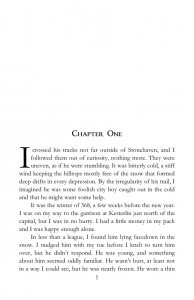
Option 2 – body font drop cap
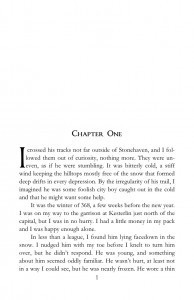
Option 3 – title font drop cap
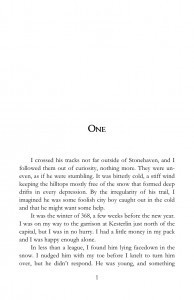
Option 4 – different chapter heading, no drop cap
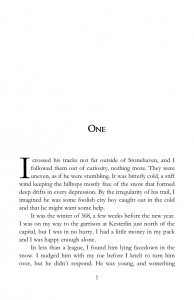
Option 5 – different chapter heading, body font drop cap
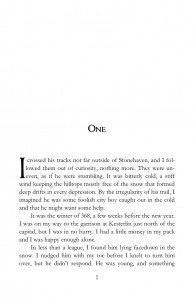
Option 6 – different chapter heading, title font drop cap

Option 7 – different body font (please let me know opinions on drop cap separately)
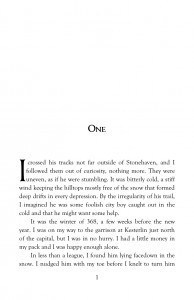
Option 8 – another body font option (disregard drop cap)
The King's Sword Trade Paper Formatting
Which formatting option do you like best? Which body font do you like best? Do you like a drop cap or not? If so, which font looks best - the title font or the body font? Any additional comments are welcome.
Option 1
Option 2
Option 3
Option 4
Option 5
Option 6
Option 7
Option 8
Other Comments:
Vote
View Results
Total Answers 6
Total Votes 4
~~~~~
You can also find me on Facebook!
The post The King’s Sword Formatting appeared first on C. J. Brightley.
No related posts.
February 4, 2013
Choosing Cover Art: Guest Post
Lindsay Buroker was kind enough to publish a guest post I wrote titled Choosing Cover Art for Your Indie Book.
One of the great things about indie publishing is that you retain so much creative control. And one of the terrible things about indie publishing is that you retain so much creative control! Choosing cover art can be a nerve-wracking experience.
Lindsay writes The Emperor’s Edge series, which I’ve been enjoying lately. Check it out! If you’re considering indie publishing, please feel free to contact me with any questions. Lindsay’s blog also has a lot of helpful information about indie publishing and marketing.
series, which I’ve been enjoying lately. Check it out! If you’re considering indie publishing, please feel free to contact me with any questions. Lindsay’s blog also has a lot of helpful information about indie publishing and marketing.
~~~~~
Please connect with me on Facebook or Google+!
The post Choosing Cover Art: Guest Post appeared first on C. J. Brightley.
ou May Also Like:
The Different Facets of Fantasy: Guest Post
How to Support Indie Authors
Self-Publishing vs. Vanity Publishing

Guest Post on LindsayBuroker.com
Lindsay Buroker was kind enough to publish a guest post I wrote titled Choosing Cover Art for Your Indie Book. Lindsay writes the Emperor’s Edge series, which I’ve been enjoying lately. Check it out! If you’re considering indie publishing, please feel free to contact me with any questions. Lindsay’s blog also has a lot of helpful information about indie publishing and marketing.
The post Guest Post on LindsayBuroker.com appeared first on .
Related posts:
Guest Post on FantasyBookCritic
Erdemen Honor Book3 Kickstarter!
Forbes Article
January 23, 2013
Guest Post on FantasyBookCritic
FantasyBookCritic was kind enough to publish a guest post I wrote about The King’s Sword. Please check it out here. You can find their main page at http://fantasybookcritic.blogspot.com.
The post Guest Post on FantasyBookCritic appeared first on .
Related posts:
Forbes Article
Erdemen Honor Book3 Kickstarter!
The King’s Sword
January 17, 2013
Erdemen Honor Book3 Kickstarter!
A Cold Wind is in final formatting for publication next week. I’m really excited about the book – I’ve had some great reactions from my early readers. The story is special to me, and I hope you love it as much as I do.
I’m also working on Book3 in the Erdemen Honor series, as yet untitled. Please check out the Kickstarter project here. The rewards include options for ebooks and signed paperback versions of all three books – The King’s Sword, A Cold Wind, and Book3 when it’s finished – as well as three short stories set in the same world – Street Fox, Heroes, and Color. There are also special rewards including bookmarks and mini-posters just for Kickstarter backers!
I’d appreciate your support – sharing this blog post is a great way to help out!
The post Erdemen Honor Book3 Kickstarter! appeared first on .
Related posts:
Street Fox
A Cold Wind
Heroes
January 5, 2013
School Days – Extra
I hope you all had a wonderful Christmas, New Years, and holiday season! I’m excited to begin this new year
This is a first scene from a short series of extras I’m working on set in the world of Erdemen Honor. It’s not a complete story or anything, just a little snippet. I’m also making good progress on Book3 and the new urban fantasy novel, tentatively titled Invisible. You can check out the Kickstarter project for Book3 here.
School Days
Chavo ran his hands over his face and through his hair. He’d arrived only the night before, barely in time for dinner. He was tired from the long ride and had stayed up late unpacking and organizing his papers in preparation for the day. He’d never taught before. It didn’t come naturally.
But with his wounded leg, he wouldn’t be fighting again. Aside from the ache that never really went away, the loss of friends and career was still fresh.
He didn’t know his fellow teachers. Didn’t know whether he wanted to. He longed for the squad he had left behind, part of the Second Kedani out of Ironcrest. Of course, some of them would swing through Kesterlin on occasion, and they’d eat and drink and reminisce together. But it wasn’t the same.
He was up early, stretched and exercised and ready to teach. But he didn’t know the routine of the school, and he was too early. The boys also exercised in the morning, and his class wouldn’t begin until they were done. He waited in his classroom. He didn’t want to watch them exercise, wanted to put off his career as a teacher a little bit longer.
After an hour, he limped to the canteen for breakfast. Bread and cheese and hot tea that he nursed morosely, staring at the table by himself. Finally, after a very long while, he decided that he’d waited long enough and limped back to his classroom. The exercise ground was silent and empty, and he hurried then, realizing he’d taken too long.
He rounded the corner of the hall and slowed as he neared the room. It wouldn’t do to look flustered on his first day. The unevenness in his steps irritated him, and he tried to make them equal, but it didn’t quite work.
The boys sat at long tables facing the front of the room. Backs straight, they watched him enter in disciplined silence.
Chavo had wanted the older students first, but the headmaster had scheduled them for later. This class was the eight and nine year olds, and they didn’t have the grasp of strategy that the older students would. He knew it was unfair, knew they hadn’t had time yet to learn, but still he expected their ignorance to annoy him.
“How far can a horse travel in one day? Assuming a good horse and adequate provisions.” He looked at a boy in the front row.
“Thirteen or fourteen leagues?” His voice was hesitant.
“What is your name?”
“Yuudai, sir.”
Chavo looked at another student.
“Ten leagues?” he guessed.
“Your name?”
“Sethna, sir.”
“Seventeen?” asked another student.
“Your name?”
“Vorun, sir.”
“And you?” he nodded toward the dark-skinned boy, the only one who wasn’t fair and blond.
“It depends on the terrain.” The boy was quiet.
“Your name?”
“Kemen, sir.”
“You are all correct.” Chavo smiled, willing himself to be fair to the boys. It was not their fault they were young. “But Kemen brings up a good point. A good horse, bred for distance and in good condition, with good provision and an experienced rider over relatively easy terrain, could go as far as thirty leagues in twenty four hours.”
The boys’ eyes widened.
“But that’s assuming a lot. It requires rest stops with water. It requires a good rider. It requires easy terrain. For the sake of discussion of tactics, we will assume no more than fourteen leagues a day, as Yuudai said. That’s a stiff pace for a group of suvari, because you have to consider the weight of the armor, weapons, and provisions as well. A less hurried pace, if you’re not trying to surprise the enemy with your speed, would be more on the order of ten or twelve leagues.”
He turned to the black slate board on the wall and drew with a piece of chalk. The rough outlines of Erdem took shape, with Stonehaven marked as a large circle near the center, Kesterlin just south, and Llewton a little to the east of Kesterlin. Pirketa was on the western coast, and Ironcrest near the northeastern border. He drew lines between them and marked the distances.
“Now then. If you want to travel from Kesterlin to Pirketa, and you want to arrive by the sixteenth of Loiste, when do you need to leave?”
He watched the boys as they tried to do the math in their head. The dark-skinned boy, Kemen, stared at the map, his lips pressed tight together.
“Kemen.”
The boy looked at him. Chavo tried not to recoil at the eerie green gaze. He was just a child, after all, and Chavo chided himself for being so disconcerted.
“On the fifth.” His answer was almost inaudible.
“Close. On the third or fourth, unless you plan to ride hard.”
The boy stared at him expressionlessly.
“That’s all for today. Tonight read the first forty pages of Ardgiter and we will discuss the implications when we next meet on Pajda.” This class met every other day, and he needed the reminder as much as they did.
“Yes, sir.” The boys bowed their heads as they rose.
Chavo watched them file out of the room. Thirty nine students. It was the largest of his classes, but not by much. At least they were not unruly.
The post School Days – Extra appeared first on .
No related posts.
December 20, 2012
Invisible – New Novel Beginning
A new novel idea struck me a couple days ago and I’ve been working on it nearly non-stop. It’s in a different world than my other books.
Comments are welcome.
***
She glanced around at before trying the door tentatively. If he was here, it was dangerous. Even if he wasn’t… well, it was still dangerous.
There was no sound from inside, and she took a deep breath before pulling her tools from her pocket. She inserted the thin metal lockpick and manipulated it carefully. She’d practiced on her own door at home, but she wasn’t very good at it yet. There was a barely audible click, and she breathed a quick sigh of relief as she turned the doorknob.
Too soon.
He spun her about and slammed her against the wall, one hand on her throat and one hand pulling the lockpick from her hand.
“Why are you here?” His voice was low and cold.
She thrashed, trying to kick him, and he evaded her efforts easily, barely acknowledging her effort. He loosened his hand, just a bit, and she gasped before he tightened his hand again. Spots swam before her eyes. This had been a very bad idea indeed.
“Why are you here?” He repeated his question, and she shook her head obstinately. She wouldn’t answer his question, not while he was choking her. She opened her mouth, trying to curse him, beg him, something, and no sound came out. The world began to turn black.
He stared at her a moment, clear blue eyes boring into her. I’m going to die. He’s going to kill me, and no one will even know. Suddenly he let go and pushed past her through the open door.
She fell to one knee and rubbed her throat. It hurt to breathe, and blinked back tears angrily. It was her own fault. She watched him through the door.
She hadn’t had a good look before, and even now, in her fear, the curiosity rose up. It’s going to get me killed someday. Probably someday soon. He wore well-worn dark trousers and a threadbare short sleeved black shirt, so thin it showed his pale skin across the shoulders. His hair was black, or close to it; she couldn’t tell in the dim light. He moved with taut grace, an athlete or a soldier, perhaps. Of average height, slim, muscular build. Age… that was difficult. Perhaps thirty? Perhaps younger? There was the slightest touch of grey in the hair near his temples but his face was unlined. Sharp features, because he had no fat to soften them, but they were attractive, she had to admit that. He tossed a rucksack on a small table and packed it with swift economy. Three more shirts, a pair of pants, four pairs of socks. And then… she craned her neck to see more.
“Leave me alone,” he said without looking up.
“I,” she hesitated. “I only meant to see if anyone lived here.”
He grunted. It was an unfriendly sound. And why should he be friendly? She’d been trying to break into his apartment. But he could have killed her, and he didn’t. She pressed her luck.
“Well, I thought you might need something. Since the power is off. That’s very odd.” She felt like she was babbling, still dizzy. She rubbed her throat again.
He didn’t answer. He picked up all six books from the desk and stacked them in the rucksack, then jerked the worn blanket off the cot, folded it, and tucked it in on top. He turned away for a moment and buckled something around his waist, and she frowned.
“What are you doing?”
“Leaving.” His voice was cold.
“Because of me?”
He grunted again. He turned back to the cot and threw the rucksack over his shoulder. Her eyes widened. He was wearing a sword, a long curved blade with a matte black scabbard. Another, shorter sword hung from his right hip.
He finally met her eyes, and she almost flinched back at the icy blue stare. She took a step back, and he walked past her into the hallway. He dropped the key at her feet without looking back at her.
“It’s yours now.”
She stared at him. He disappeared at the end of the hallway, and she hesitated. She was almost crazy enough to go after him.
The post Invisible – New Novel Beginning appeared first on .
Related posts:
Basileus and the Cat
December 4, 2012
How to Choose and Use Beta Readers
Every writer needs beta readers. But sometimes, finding the right beta readers can be a challenge.
The best critiquers and beta readers catch the vision of the story you want to tell and help you tell it better, rather than fundamentally changing the idea.
There are a few critical steps to identifying the right beta readers for your work and using them well.
1 – Know what you need from the beta readers.
When you show a piece of writing to someone, it’s best to know what kind of response you’re looking for.
If you need encouragement, show it to your mom or your best friend! It’s ok. Lots of writers say you always need a critical eye if you’re going to improve, and maybe that’s true. But sometimes what you really need is encouragement to keep writing and get the rest of the story down. When you need encouragement and a kick in the rear to keep going, it’s ok to show the piece to a less-than-critical reader. As long as you understand you’re not getting unbiased feedback, it can be exactly what you need at that time.
If you need an overall reaction, a general check for “did this work for you?,” I’ve found that most of my best reactions came from readers who were not writers. Writers often, in an attempt to be helpful, try to identify what didn’t work for them in your story. Sometimes they’re right. But often, especially if they have a very different writing style or a very different type of story they prefer, they can be tragically/comically wrong. A reader might say, “Yes, it worked / No, it didn’t work, I didn’t identify with your character at all / I was confused about X / whatever.” Whereas a writer might say, “I think your pacing is off / I think you told rather than showing / your character is too flat.”
What’s the difference? I’ll use my novel The King’s Sword as an example. The first draft was very bare bones – I’m a very spare writer, and I left a lot to the imagination. Too much, in fact. The whole novel was about 55k words. In final form it’s about 75k, for reference, which is fairly short for fantasy but close to average for mainstream adult fiction. Some readers (who were not writers) loved it. Some said, “I’m not sure I’m getting much from the first quarter of the book, but the characters are growing on me.” Most of my critiques from writers said “the pacing is off, nothing happens in the first half of the book.” I was baffled, because I felt that a lot happened – it was character development, rather than an actiony plot, but it was still not empty space on the page with nothing happening. Because I’m such a spare writer, there’s nothing that goes on the page that doesn’t serve a purpose… I, like everyone else, have flaws in my writing, but fluff isn’t one of mine! I’ll explain what those critiques yielded in the next section.
If you need detailed writing help, fellow writers are probably your best resource. Sometimes you need help refining your plot (the actions of the story). Sometimes you need help refining your story (the internal and external changes in the characters and the plot). Sometimes you need help with world-building (and no one loves world-building like fellow writers!). Sometimes you just need someone to commiserate with when things aren’t going well. Writers understand these things.
2 – Know the story you want to tell.
One of my beta readers, who is immensely talented and skilled at critiquing, noted that in The King’s Sword, I was telling a character story but I’d accidentally set people’s expectations for an actiony plot adventure story. Some of readers who just read what was on the page started to get it. Some didn’t. The writer-critiquers paid attention to their initial expectations (largely shaped by the genre label “fantasy”) and then were disappointed because I didn’t fulfill them. When I edited, my job was to set expectations better and make it more clear what kind of story I was telling – a character story rather than an action thriller type. It’s not that one type of story is wrong, but if you pick up a book thinking it’s one thing, and you get something completely different, it’s very likely you’ll be disappointed. Many of the writer-critiquers wanted me to fundamentally change the story to make it more “exciting,” which really meant “to better fit their expectations of a fantasy novel.” But the story I wanted to tell was plenty exciting… it was just different.
Were those writer-critiquers wrong? Well, they correctly put their finger on a problem that needed to be fixed. That draft DID have flaws, since what I was trying to do wasn’t clear enough for them to get it. It’s a much stronger book now partly because their critiques. But misidentifying that problem as a pacing problem, rather than a what-story-am-I-actually-telling problem, wasn’t as helpful as any of us would have wished. Incorrect diagnoses of writing problems can send writers down rabbit trails, trying to fix things that aren’t really a problem in the first place. It can mess with, even ruin a book, and it can be extremely detrimental to a writer’s ability to tell their own stories.
It’s WONDERFUL to have fellow writers willing to critique your work and help make it better. My point isn’t to bash that at all! It takes a lot of time and effort to critique someone else’s work, and whenever anyone does that for you with the intent of being helpful, the correct response is gratitude. Fellow writers can be incredibly generous with their time and energy, and I’m grateful for every critique I received. But, as the writer, you need to know what story you’re trying to tell before you put your work out there to be read and critiqued. You can then evaluate the feedback you receive in light of “does this feedback help me tell that story better?” A lot of critique problems result from a combination of critiques that misidentify problems, and writers who A) don’t know what story they’re trying to tell, and B) don’t evaluate the feedback they receive critically.
I was fortunate in that several of my beta readers helped me parse through all the feedback I received to find the root of the problem. The story I had envisioned, the story in my head, was sketched out in such spare detail on the page that the internal story arcs weren’t clear to readers, even though they were as clear as day to me. The problem was HARD to identify, and I’m not surprised that very few of the beta readers even touched on the real problem. That’s more a result of my story than any slam on them – if I’d been my own beta reader, I wouldn’t have identified it either! But it highlights the responsibility you, as the writer, have to understand your own story and your goals and then to look at the feedback in light of your goals. Negative feedback tells you SOMETHING… but it might not be what the reader or critiquer thinks it tells you. You, as the writer, need to figure out what to do with that knowledge.
3 – Know your beta readers.
One of my beta readers in particular loves characters like Kemen. One doesn’t. She’s an excellent beta reader, but it’s helpful for me to know that this general type of character isn’t really her cup of tea. That doesn’t mean she won’t like the book, or that her feedback isn’t useful… in fact, it might be more useful, in a critiquing sense, than the feedback I receive from Kemen’s fan club (yes, he has one). They love him, which of course makes me happy as a writer, but they don’t view him as critically or question his actions the same way. Some readers just aren’t into stories with the type of internal story arcs that I write. That’s fine. Their feedback can still be valuable, if they’re willing to read and comment on my books. It can be useful to get feedback from people who don’t normally read fantasy, or aren’t into certain kinds of characters, because they’ll bring a different perspective. This might be more useful for me, since my books don’t fall as neatly into the fantasy genre as some others, but it’s something to be aware of. Some beta readers can enunciate their preferences and biases clearly, and many can’t. Know your beta readers and their preferences, and view their feedback in light of that.
The post How to Choose and Use Beta Readers appeared first on .
Related posts:
Forbes Article
How to Support Indie Authors
November 17, 2012
How to Support Indie Authors
First, let’s be clear: you shouldn’t support indie authors because they’re indie. Forgoing the traditional publishing route is a business decision for authors that is complicated for a number of reasons – royalties, marketing support, time-to-publication, local vs. international distribution, and creative control, among many other considerations. But none of that should influence whether a reader supports a particular author. The reader should choose to support a particular author for one reason and one reason only: they write books the reader wants to read.
Support authors who write books you enjoy, and you can’t go wrong!
That said, if you’ve found an indie author whose books you enjoy, congratulations! In some ways it’s much easier for an individual reader to make a difference in the career of an indie author. Indie authors survive because of readers like you! If you like an author’s work, you can help them out in a number of ways.
1 – Buy their books!
Every author appreciates every book purchase. But indie authors in general receive higher royalties than traditionally published authors, so you can buy knowing that you’re directly supporting the author.
2 – Write a review
Because indie authors typically don’t have any marketing support (or if they have it, they pay for it out of pocket rather than out of royalties), they rely on reviews from readers to get publicity started. If you enjoyed a book, please write a review on Amazon (or wherever you purchased it). The most detailed reviews are the most helpful for potential buyers, so the extra effort it takes to write a more in depth review that tells what you liked and why (without spoilers!) is really appreciated.
3 – Tell your friends.
Not everyone will like every book. Indie authors don’t expect readers to email blast everyone they’ve ever met about how awesome their book is. But if you have a friend(s) you think would enjoy it, please let them know! Word of mouth and personal recommendations are the very best advertising.
4 – Give the book as a gift.
Know someone who might enjoy the book? Give it to them as a gift! Amazon and Barnes and Noble both make giving ebooks easier than ever – all you need is the recipient’s email address.
5 – Subscribe.
Many indie authors have email newsletters and/or blogs. Subscribe to them! Generally they contain news on what the author is working on and sometimes discounts on new releases. Forward them to people who you think might enjoy the author’s books! It’s easy, it’s free, and every sale is appreciated.
6 – Social media.
Are you on Facebook? Twitter? Follow the author! It’s a great opportunity to engage with your favorite authors, find out what they’re working on, and contribute to their success by encouraging them and helping promote their work. Likes on a new release announcement can really add up! Plus, indie authors are often very willing to engage with readers, and you might develop real friendships. You can find my Facebook page here and my Twitter here.
7 – Tag their books.
Back to Amazon – down near the bottom of each book’s page, there’s a section where you can tag the book. Please do this! You can agree with the current tags or come up with your own. Tags help readers find books, so genre and descriptive tags are best.
8 – Like their books.
Barnes and Noble’s Like function is actually a Facebook Like. Amazon’s is separate but works in a similar way. The more Likes a book has, the more Amazon will promote the author’s book! Liking a book is quick and easy, and very much appreciated!
9 – Tell your library or book club.
Indie authors typically aren’t carried by many libraries. But what better way to gain new fans than through a library or book club? If you enjoyed the book, mention it to your local library or your book club as a potential acquisition.
10 – Keep reading!
You are the reason indie authors write! If you love their work, please keep reading it! Let them know you look forward to their next book or story. I love to hear from readers!
The post How to Support Indie Authors appeared first on .
Related posts:
Forbes Article
How to Choose and Use Beta Readers
November 16, 2012
Forbes Article
This is a really interesting article on the tension between traditionally published authors and indie authors. Link here.
I chose to self-publish for a variety of reasons.
My first book, The King’s Sword, was rejected by a number of agents before I decided to self-publish. While I’m sure it’s not perfect (what book is? We all have things we can improve in our writing, and I hope I continue to grow as a writer throughout my life.), I believed it was worth sharing. The comments I got from beta readers ranged from fangirl squeals (literally) to “Wow, I’ve never seen a first novel like this… this is really REALLY good” to “What? What are you doing? This is not a fantasy. Or a lit-fic. I don’t know what this is. But I don’t like it.”
I know what I intended to do with the novel. I think I succeeded. Some readers think so too, but not all. Some readers didn’t get what I was doing at all. Some readers got it but didn’t like it. No book pleases everyone. It’s not a “typical” high fantasy, that’s for sure. And from the rejections I got from agents, their issues weren’t primarily with my writing itself, but with the inability to put the story in an easily marketable box.
I’m ok with that. I hope you enjoy it. I enjoyed writing it.
If you did enjoy it, please check out this post on how to support indie authors.
The post Forbes Article appeared first on .
Related posts:
How to Support Indie Authors
How to Choose and Use Beta Readers



